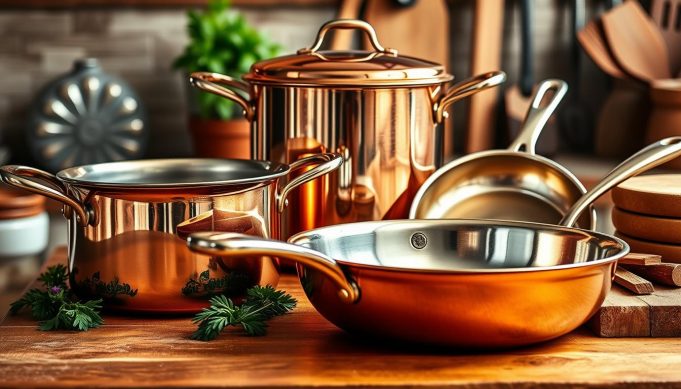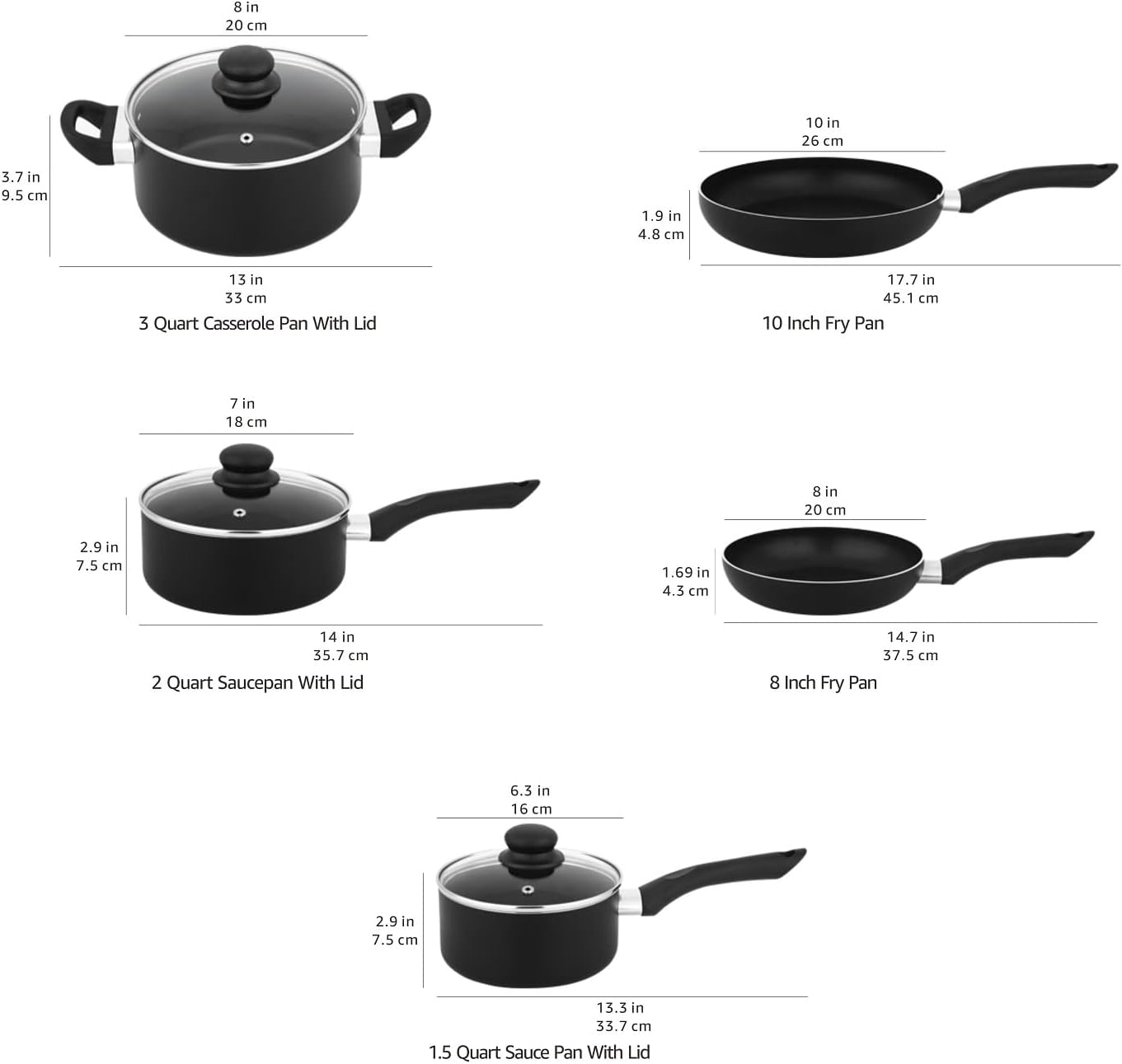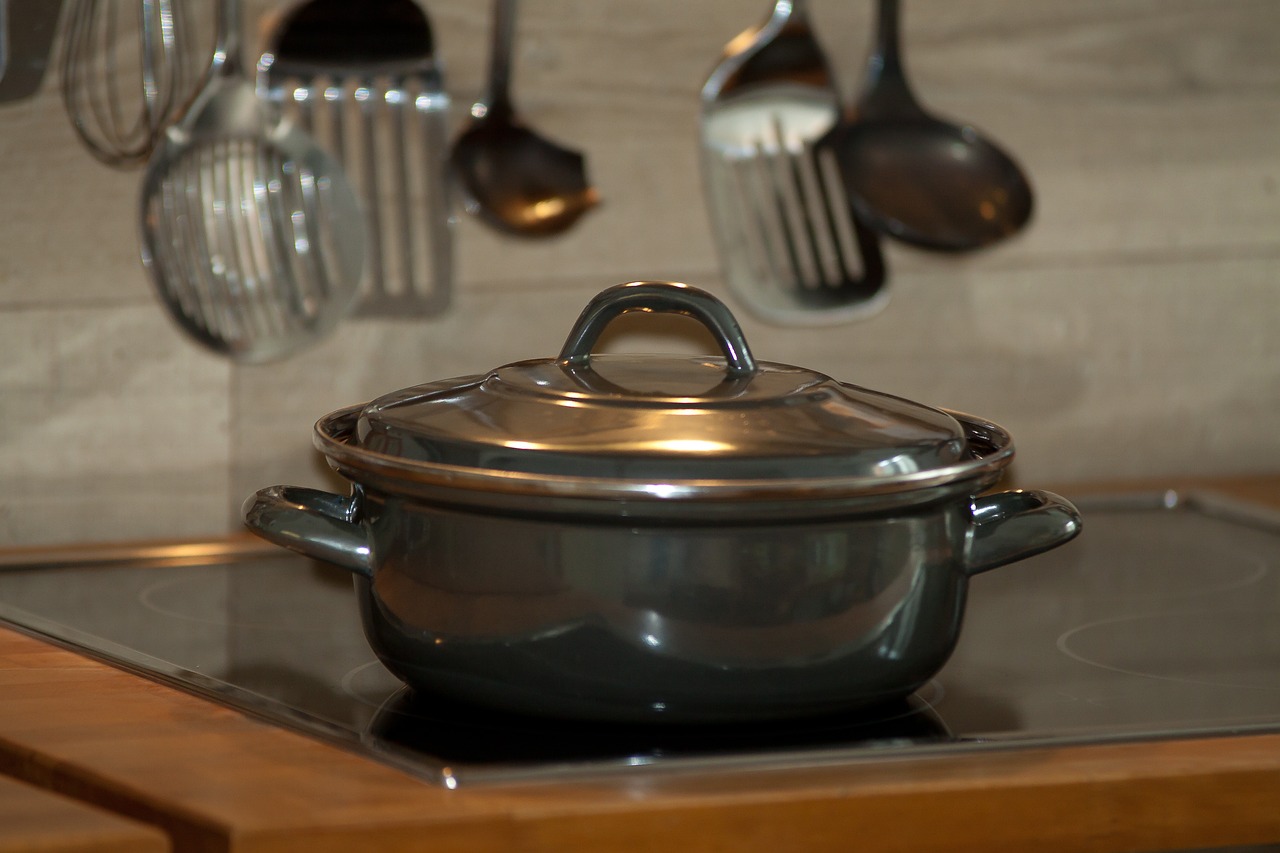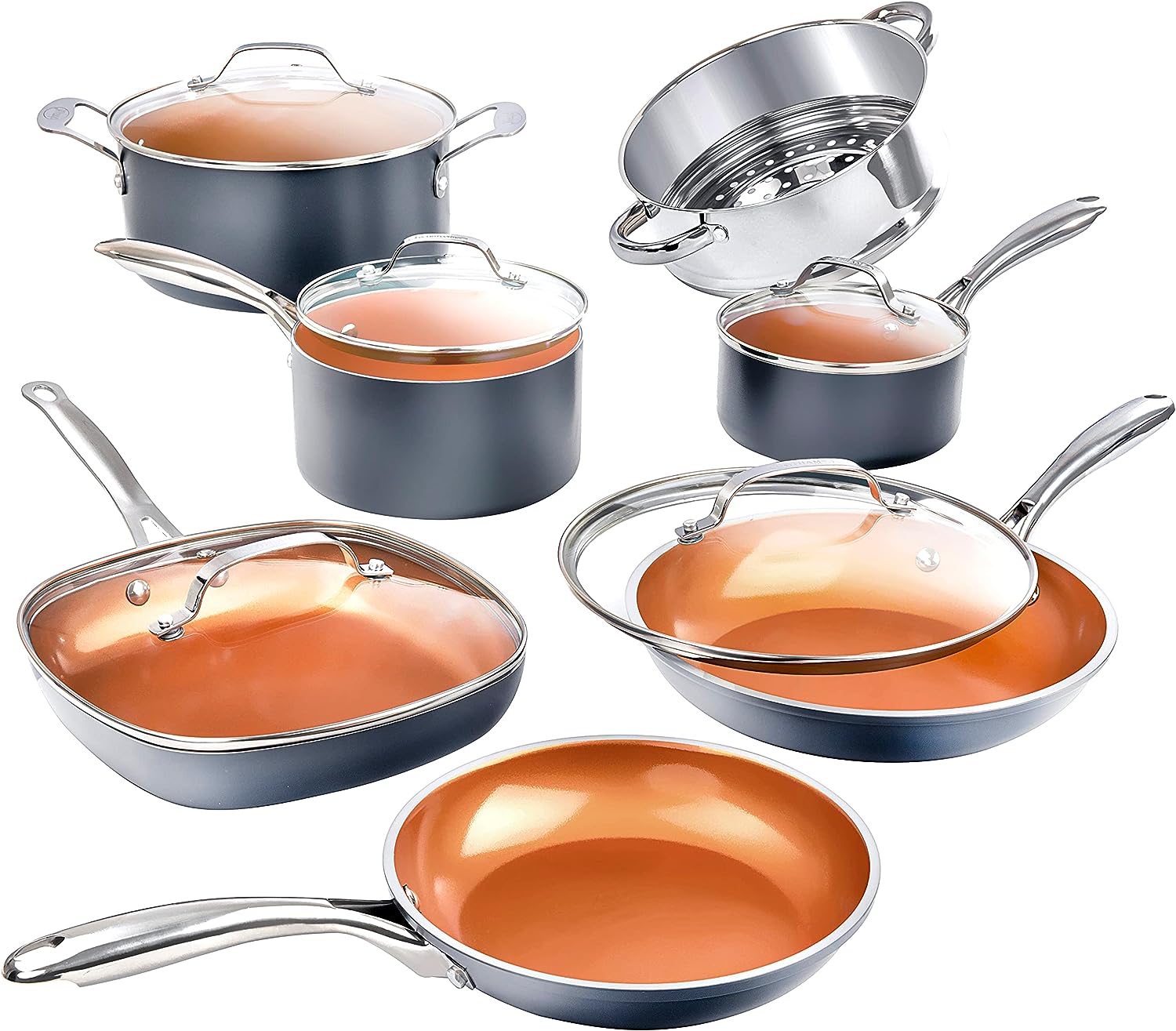Did you know a single copper pot can cost over $5001? With such a big investment, it’s key to clean and maintain your copper cookware well. Copper heats up fast and evenly, which is why chefs and home cooks love it. But, copper can tarnish and get a bad patina easily2.
In this guide, we’ll show you how to keep your copper cookware in top shape. We’ll cover basic washing to advanced tarnish removal. You’ll learn how to make your copper pots and pans shine like new123.
Key Takeaways
- Copper cookware should be washed after every use and polished regularly to prevent tarnishing.
- Top-quality copper pans are often lined with tin or stainless steel to prevent direct contact with the copper.
- Baking soda, lemon, and vinegar are effective natural cleaners for removing stuck-on food and tarnish from copper.
- Proper storage and handling, such as avoiding stacking and exposure to sunlight, can help maintain the shine of copper cookware.
- Expert advice recommends hand-washing copper pieces and avoiding the dishwasher to preserve their quality.
Understanding Copper Cookware
Copper cookware is loved by both professional chefs and home cooks. It’s known for its great heat conductivity and quick response. This makes it perfect for cooking delicate dishes and sauces that need careful attention4.
Benefits of Cooking with Copper
Copper cookware is great because it distributes heat well. It heats up fast and evenly, preventing scorching. This quick heating and cooling is key for searing meats and simmering sauces4.
It’s a valuable tool in the kitchen. Chefs can easily get the perfect results with it.
Common Copper Cookware Styles
Copper cookware comes in many shapes and sizes. You can find everything from saucepans and frying pans to stock pots and saute pans. Its versatility makes it a must-have for both home cooks and professional chefs5.
Signs Your Copper Cookware Needs Cleaning
As copper cookware ages, it can tarnish or get food stuck on it. Look out for discoloration, dull spots, and grime buildup. These signs mean it’s time to clean your copper pans and pots4.
Keeping copper cookware shiny is key. It not only looks good but also cooks better.
The patina that forms on copper cookware is often seen as a plus. It adds to the pieces’ beauty and character. But, if the tarnish gets too much or hinders cooking, it’s time to clean it4.
Tin-lined copper cookware needs special care. The tin lining can melt at high temperatures, so it’s important to avoid overheating.
Essential Cleaning Supplies
To keep copper cookware shining, you need the right cleaning tools. Make sure you have mild dish soap, cellulose sponges, ketchup, fine sea salt, distilled white vinegar, and all-purpose flour6. For tough stains or tarnish, try Matfer Bourgeat Bistro Copper Cleaning Paste, Bar Keepers Friend Soft Cleanser, or Wright’s Copper Cream7. But, stay away from harsh chemicals and abrasive scrubbers to avoid damaging the copper.
Recommended Cleaners for Copper
- Mild dish soap and water
- Ketchup or tomato paste
- Fine sea salt and white vinegar
- Commercial copper polishing pastes
Tools for Effective Cleaning
- Soft, non-abrasive cellulose sponges
- Microfiber cloths for drying and polishing
- Rubber gloves to protect hands
- All-purpose flour for a natural scrubbing agent
Safety Precautions
When using copper polishers, always wear gloves and work in a well-ventilated area7. Cooking acidic foods in unlined copper cookware can be harmful, as it may leach copper into the food7. Be sure to protect any tin or stainless steel linings to avoid direct copper contact.
“Proper care and cleaning of copper cookware is essential for preserving its beauty, functionality, and longevity.”
Basic Cleaning Techniques
Cleaning copper cookware right is key to keep it shiny and working well. It’s important to be gentle with copper and steer clear of harsh cleaners that can harm it8.
Hand Washing Copper Cookware
Hand washing is the softest way to clean copper. Start by filling a sink or big basin with warm water and a bit of mild dish soap. Use a soft sponge or cloth to gently rub the copper in circular motions2.
Don’t use rough scouring pads or steel wool. They can scratch the copper2.
Using Soap and Water
For a deep clean, soap and water are perfect. Mix a few drops of mild dish soap with warm water. Then, use a soft-bristled brush or cloth to clean the copper2.
Rinse the cookware well to get rid of any soap left behind.
Drying Properly
Drying copper right is important to stop water spots and tarnish. After cleaning, dry the copper with a soft, lint-free cloth2. Don’t let it air dry, as moisture can cause it to tarnish faster9.
By sticking to these basic cleaning steps, you can keep your copper cookware looking great and working well. Remember, gentle care and paying attention to details are essential for keeping copper in top shape8.
Advanced Cleaning Methods
Cleaning tarnished copper cookware or removing stubborn copper stains often needs advanced techniques. A paste made from fine salt, flour, vinegar, or lemon juice is effective10. Apply it to the copper, let it sit, then rinse and dry well. This method helps pull the tarnish off the surface.
The lemon and salt method is also popular. Cut a lemon in half, sprinkle salt on it, and scrub the copper11. The lemon’s acidity and salt’s grit can remove stains and restore shine. For tough tarnish, try commercial cleaners like Twinkle or Bar Keepers Friend11.
The type of copper cookware affects cleaning methods. Some pots and pans have a tin lining that needs special care12. For these, vinegar and salt can safely remove green rust or discoloration12.
Always follow the manufacturer’s cleaning instructions and safety tips. Proper care and cleaning keep your copper cookware looking great for years.
Dealing with Tarnish
Copper cookware can get a dull, dark layer called tarnish as it ages. This happens when the metal reacts with air and moisture. While tarnish isn’t harmful, it can make your copper pots and pans look less shiny. Luckily, there are ways to make them shine again and stop tarnish from coming back.
How to Identify Tarnish
Tarnish looks like a thin, uneven film on copper. It can be dark brown to greenish-black. If you see this, it means your copper cookware needs some cleaning13.
Removing Heavy Tarnish
For copper that’s really tarnished, you need a stronger cleaning method. Mix lemon juice, salt, and a bit of flour to make a paste13. Put the paste on the tarnished spots, wait a few minutes, then scrub gently with a soft cloth or sponge13. The lemon juice’s acidity and the salt’s grit help remove tarnish. The flour makes the paste smooth and easy to spread13. After cleaning, make sure to dry the copper well to stop tarnish from coming back.
Preventing Future Tarnish
To keep your copper cookware in top shape, clean and polish it regularly14. Experts say to do this a few times a year to keep it shiny14. Also, apply a thin layer of mineral oil to the outside when you store it1. This oil acts as a shield against tarnish.
Learning how to spot and fix tarnish helps keep your copper cookware looking great and working well for many years.
Storing Copper Cookware
Storing copper cookware right is key to keeping it shiny and lasting longer15. To keep it looking great, store it in a dry, cool spot16. Make sure it’s away from moisture to avoid ugly stains.
Tips for Proper Storage
- Keep copper cookware in a dry, well-ventilated area, away from sunlight or humidity16.
- Hang copper pots and pans to show off their beauty and keep them safe15.
- If you must stack, use soft cloth or felt to prevent scratches15.
Avoiding Scratches and Damage
Be gentle with your copper cookware to avoid scratches or dents15. Store each piece separately. Use protective liners or bags made for copper to prevent damage16.
Using Liners to Protect Surfaces
For long-term storage, wrap copper in acid-free tissue or use copper storage bags15. These steps help keep the copper shiny and prevent stains16.
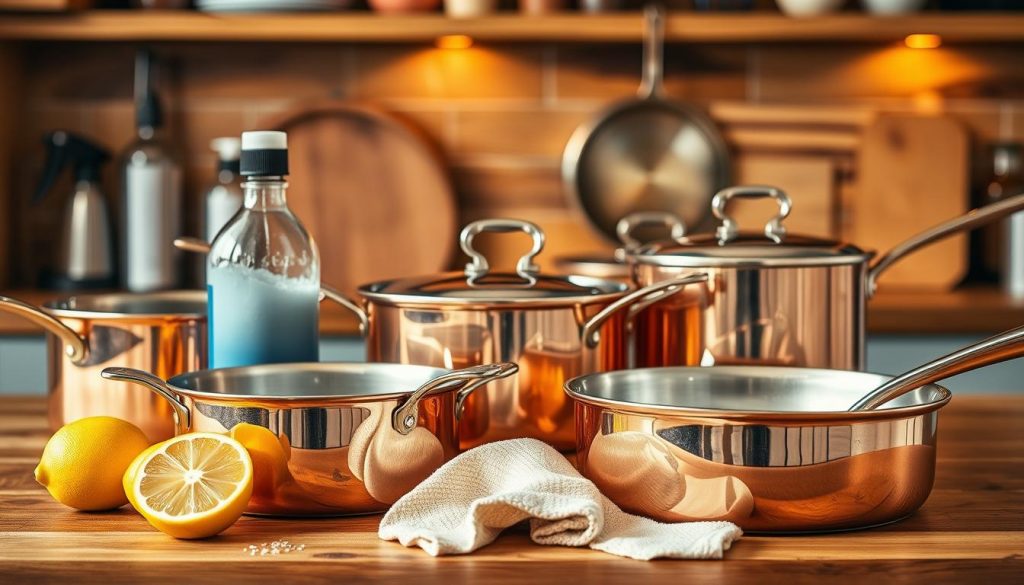
By storing your copper cookware correctly, it will stay beautiful and work well for years15. Taking good care of it is essential for keeping its shine and copper cookware maintenance.
Caring for Copper Cookware Handles
Copper cookware is a beautiful and versatile choice for the kitchen. It needs special care to keep its shine and function well. The handles are often forgotten, but they must be cleaned and maintained just like the rest of the cookware.
Cleaning Different Handle Materials
Cleaning copper handles is similar to the pot or pan itself. Use gentle methods to avoid scratches. Copper cookware needs more care because it’s softer than steel or cast iron.17
Iron handles require a different cleaning method. Use a neutral oil like mineral oil or grapeseed oil to prevent rust. Rust can appear on cast iron handles if they’re not dried well after washing.17
Stainless steel handles can be cleaned with dish soap and water. Make sure to rinse and dry them well to avoid residue buildup.
Keeping Handles Free of Residue
Cleaning the crevices where handles attach is key, no matter the material. The exterior of copper products naturally tarnishes, forming patina or verdigris.17 This can lead to verdigris, causing pitting if not cleaned. Ensure all these areas are well cleaned and dried after each use.
Proper care for your copper cookware handles ensures they last and perform well for years. Remember, never use bleach on copper cookware as it can be corrosive and cause pitting.171816
Maintenance Tips for Longevity
Keeping your copper cookware looking great and working well is key. A regular cleaning routine and deep cleaning now and then will help. This way, your copper pots and pans will stay shiny and perform well for a long time19.
Regular Cleaning Schedule
It’s important to clean your copper cookware after each use. This stops residue and tarnish from building up19. Use gentle cleaners like vinegar, salt, lemon, and dish soap for cleaning19.
Soft cloths, sponges, or brushes with soft bristles are best to avoid scratches19. You can also use ketchup or copper cleaners to keep it shiny19.
Seasonal Deep Cleaning
Deep cleaning and polishing your copper cookware every few months is a good idea19. Boiling vinegar and water can remove tough tarnish19. A lemon juice and baking soda paste works well too19.
For tin-lined copper, watch for wear and tear. If needed, get it professionally re-tinned20. Don’t let copper pans get too hot, as it can harm the tin lining20.
Regular cleaning and occasional deep cleaning keep your copper cookware looking and working great19. Taking care of it is the secret to keeping it shiny and lasting long20.
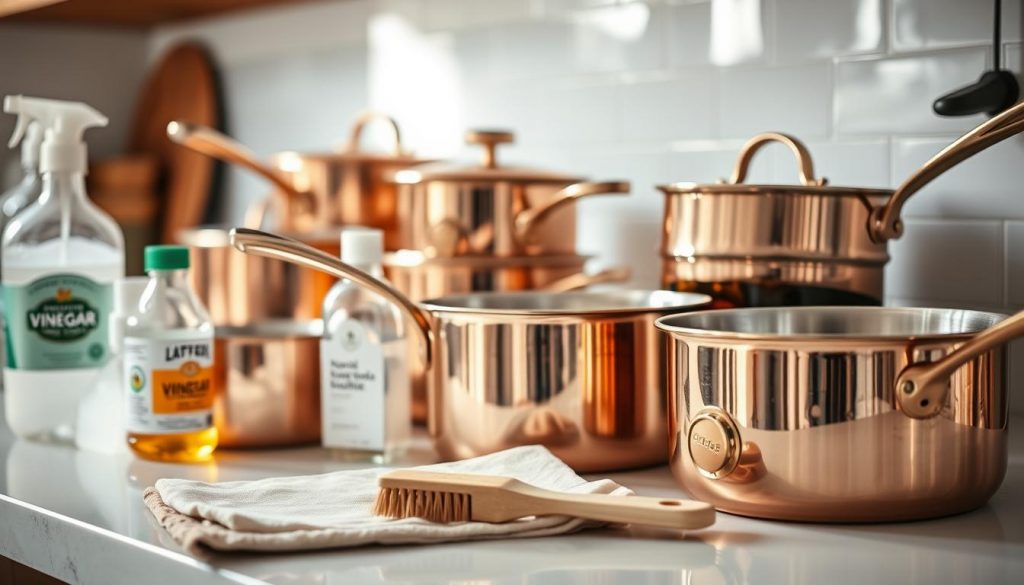
“Copper cookware is renowned for its excellent heat conductivity, which enhances cooking efficiency and experience.”20
Why Avoid Non-Stick Cookware
Choosing between copper and non-stick cookware affects your health and the planet. Copper is better because it conducts heat well and lasts long. It’s a better choice than non-stick options.
Comparisons Between Copper and Non-Stick
Non-stick coatings, like Teflon, contain harmful chemicals called PFAs. These chemicals can cause cancer, infertility, and liver damage, says the FDA and CDC21. They also stay in soil and water for thousands of years21.
Copper cookware, when lined with tin or stainless steel, is safe and durable. It doesn’t need harmful coatings.
Health Considerations
Unlined copper can leach harmful metals into food. But lined copper is safe and lasts long21. Cast iron is also safe and lasts a long time, great for those who need more iron21.
Aluminum cookware’s safety is uncertain, as it can react with acidic foods21. Silicone utensils are safe but hard to recycle because they last so long21.
Copper cookware lasts for generations, making it a greener choice than non-stick22. It’s easy to clean with natural methods like lemon and salt or vinegar22. Copper is the best choice for those who care about health and the environment.
“Copper cookware, with its superior heat conductivity and exceptional longevity, stands out as a superior choice compared to non-stick alternatives.”
Eco-Friendly Cleaning Alternatives
We’re looking for natural ways to keep our copper cookware shiny. Luckily, there are many green options. We can make our own cleaners using things we already have at home. This way, we avoid harsh chemicals.
Natural Ingredients for Cleaning
Mixing flour, salt, and vinegar or lemon juice makes a great cleaner23. This combo gently removes tarnish and grime. The vinegar or lemon also breaks down oxidation.
Ketchup is another good choice, thanks to its vinegar and salt23. But, the flour-salt-vinegar paste is safer and works better, says the author23.
DIY Copper Cleaner Recipes
For a DIY polish, mix baking soda and lemon juice into a paste23. Rub it on the copper, wait a bit, then rinse and dry. This combo cleans and shines copper well.
Try a ketchup, salt, and water paste too23. Apply it, wait, then wipe with a damp cloth. The acid in ketchup and salt clean copper nicely.
Using these green cleaners helps our copper last longer242325. With a bit of effort and household items, we can keep our copper looking great. This way, we stay true to our eco-friendly goals.
Final Thoughts on Copper Cookware Care
Summarizing Key Cleaning Techniques
Keeping our copper cookware in top shape is key. We should clean it gently to keep its shine and performance at their best26. Always hand wash with mild soap and lukewarm water. Avoid harsh cleaners that can damage the surface26.
For extra shine, polish with a mix of white vinegar and salt or lemon juice and salt26. If tarnish appears, use a baking soda and lemon juice paste or a commercial cleaner. Then, polish with a soft copper polish26.
Embracing the Beauty of Copper Cookware
As copper cookware ages, it gets a beautiful patina. This adds character and depth to our kitchen26. Instead of seeing it as a flaw, we should celebrate this natural change, which makes our cookware more beautiful26.
With the right care, our copper cookware will last long and cook well. It will also keep its elegant look for years2627.
By using the cleaning and storage tips from this guide, we can keep our copper cookware in great shape. This way, we preserve its beauty and shine26. Copper is a great choice for cooking because of its heat transfer and antibacterial properties26.
FAQ
What are the benefits of cooking with copper cookware?
What are the common styles of copper cookware?
How can I tell if my copper cookware needs cleaning?
What are the essential supplies for cleaning copper cookware?
How do I hand wash copper cookware?
What are some effective methods for cleaning heavily tarnished copper?
How can I prevent future tarnish on my copper cookware?
How do I clean and maintain the handles on my copper cookware?
What are the benefits of copper cookware compared to non-stick options?
Can I use eco-friendly ingredients to clean my copper cookware?
Source Links
- How to Clean Copper Pans and Keep Them Shiny
- How to Clean Copper Pans and Other Copper Surfaces Naturally
- How to Clean Copper Cookware So It Always Gleams
- How to Clean and Care for Copper Cookware
- How do you actually use, clean, and care for your copper?
- How to Clean and Care for Copper Cookware
- How to Clean Copper Cookware
- How to Care for Copper Cookware
- How to Clean and Polish Copper Homewares
- Oops! How to Clean the Tin Lining in Copper Pots.
- How To Clean Copper Pans
- How To Properly Maintain Japanese Kitchenware: A Guide To Caring For Copper
- How to Clean Tarnished Copper Pans
- Time to Clean and Polish the Copper – The Martha Stewart Blog
- How to Use, Store and Care for Your Copper Cookware
- How to Care for Copper Cookware
- Falk Copper Cookware::Caring For Your Copper Cookware
- Use and Care
- Polishing Perfection: How To Clean Copper Cookware
- How to Clean Copper Cookware – This Old Baker
- Why Non-Toxic Cookware Is Essential For A Healthy Kitchen
- How to Clean Copper Cookware for That Like-New Shine
- Make It Yourself: Copper Cleaner • Everyday Cheapskate
- How to Clean a Burnt Copper Pan A New & Easy Way
- All-Natural Copper Cleaning Tip
- Caring for Copper
- cleaning copper cookware | Miss Mustard Seed


